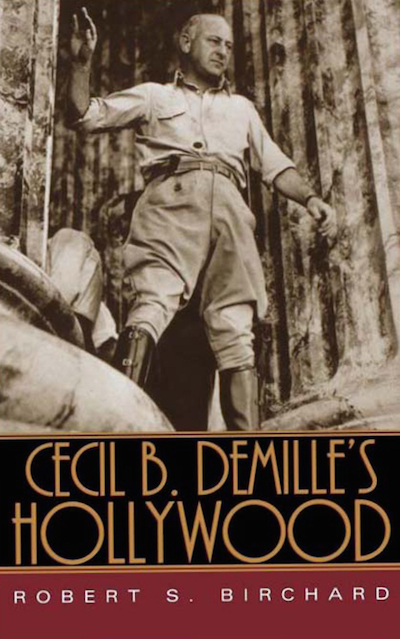Denise Morse and Robert Birchard. Photo credit: Joe Yranski.
Over Labor Day weekend, I attended three memorial events for Robert S. Birchard, who I knew and respected as a film preservationist, as a film historian, and as a guiding light of the Cinecon Classic Film Festival. First, there was Bob’s interment on Wednesday at Hollywood Forever Cemetery. Then, Thursday evening, Cinecon 52 opened with a “For Bob” tribute. Finally, there was the official memorial at Cinecon on Friday, staged at the Egyptian Theatre, which included personal, epistolary, and video eulogies by Cecilia DeMille Presley, Kevin Brownlow, Leonard Maltin, Sue Lloyd, Stan Taffel (Cinecon’s new president), and Bob’s longtime girlfriend, Denise Morse, among others.
Even though we were never close friends, I think I knew Bob Birchard long enough to set down my own thoughts on his sudden death. I first met Bob in Syracuse, New York at “Cinefest” in the late-1980s. I was at George Eastman Museum in Rochester, and he was one of the West Coast film collectors who made an insane journey to upstate New York in early March, when the weather couldn’t be more miserable; all for love of old movies. Leonard Maltin and Michael Schlesinger were two other transplanted Angelenos who were Syracuse regulars and cinephiles. Having moved from academia to archiving, the world of film and film memorabilia collectors was new to me, but I understood that this community was the first line of defense for preservation, when colleagues in established archives were telling me to not get mixed up with that bunch.

I really didn’t get to know Birchard better, until I moved to L.A. in 1998 to work at Universal. Shortly after I arrived, Bob invited me to an all-day tour of L.A. studios and other sites of film historical interest, including the Max Sennett Studio in Edendale, the Selig-Polyscope Zoo in Lincoln Heights, the stairs in Laurel & Hardy’s The Music Box (1932), Marilyn Monroe’s grave in Westwood, etc. It was then that I realized the encyclopedic depth of Bob’s film historical knowledge, which is reflected in many articles and his magnum opus, Cecil B. DeMille’s Hollywood (2004).
Then, while I was at Universal, Bob helped me out on a project. The studio had decided to brand all streets and buildings on the lot, and John Ford was on the list. Since Ford only worked at Universal in the 1910s, material was hard to find. Needless to say, Bob generously provided the images from those Harry Carey westerns he truly loved, and as far as I know, they are still hanging as oversized blow-ups in the lobby.
When I took a job at the now shuttered Hollywood Entertainment Museum, our relationship was a little more ambiguous, because he was skeptical of HEM’s mission and administration. He also said he understood, I had to put food on my family’s table, as if to morally absolve me from consorting with the enemy. I did know where he was coming from, because he had worked so hard for the Hollywood Heritage Museum, a group that included Randy Haberkamp, David Shepard, Robert Noodleman, Beth Werling, Sue Lloyd and many others. They had managed successfully to save the Jesse Lasky Barn, where Cecil B. DeMille shot his first feature, The Squaw Man (1914), and place it on the property that had been reserved since the mid-1960s for a planned but never executed Hollywood Museum. The Heritage Museum is still there today, thanks in part to Bob’s continual efforts.
While at HEM, I had also become the founding editor of The Moving Image and was constantly looking for articles on film archives. In another volunteer project for both of us, I published his memoir of the early years of UCLA Film & Television Archive, “Nitrate Machos vs. Nitrate Nellies: The Buccaneer Days of UCLA Film & Television Archives” (Spring 2004). It was maybe one of the best pieces of writing I ever published, needing virtually no editing.
While working at HEM, I also started volunteering at Cinecon, a practice I have continued to this day. Stella Grace who has wrangled Cinecon volunteers and hotels for decades told me recently that Bob would always go to Stella and ask her if she knew who I was, shaking his head when she would say yes. By that point I was having lunches with Birchard so he could find out what new restorations were cooking at UCLA, and had a free pass waiting for me, but I, too, was a cinephile.
I could not have been happier when Bob was given an important position at the American Film Institute’s cataloguing project on American feature films. It was a perfect fit for Bob’s passion for film history and his punctilious detail orientation. I know he was happy there and I was happy for him. We had both managed to land on our feet at an age when most are not given another chance, and we knew it. I would see him frequently at Academy screenings or other events, usually with his girlfriend Denise, and I could tell he was happy, by the way he was more at ease.
Rest in peace, my friend.
< Back to Archival Spaces blog






 Mobile Navigation
Mobile Navigation

